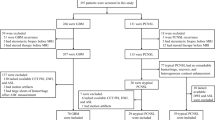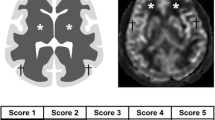Abstract
Objectives
To evaluate the ability of the initial area under the curve (IAUC) derived from dynamic contrast-enhanced MR imaging (DCE-MRI) and apparent diffusion coefficient (ADC) in differentiating between primary central nervous system lymphoma (PCNSL) and atypical glioblastoma (GBM).
Methods
We retrospectively identified 19 patients with atypical GBM (less than 13 % necrosis of the enhancing tumour), and 23 patients with PCNSL. The histogram parameters of IAUC at 30, 60, 90 s (IAUC30, IAUC60, and IAUC90), and ADC were compared between PCNSL and GBM. The diagnostic performances and added values of the IAUC and ADC for differentiating between PCNSL and GBM were evaluated. Interobserver agreement was assessed via intraclass correlation coefficient (ICC).
Results
The IAUC and ADC parameters were higher in GBM than in PCNSL. The 90th percentile (p90) of IAUC30 and 10th percentile (p10) of ADC showed the best diagnostic performance. Adding p90 of IAUC30 to p10 of ADC improved the differentiation between PCNSL and GBM (area under the ROC curve [AUC] = 0.886), compared to IAUC30 or ADC alone (AUC = 0.789 and 0.744; P < 0.05 for all). The ICC was 0.96 for p90 of IAUC30.
Conclusions
The IAUC may be a useful parameter together with ADC for differentiating between PCNSL and atypical GBM.
Key Points
• High reproducibility is essential for practical implementation of advanced MRI parameters.
• IAUC and ADC are highly reproducible parameters.
• IAUC values were higher in atypical GBM than in PCNSL.
• Adding IAUC to ADC improved the differentiation between PCNSL and GBM.
• IAUC with ADC are useful for differentiating PCNSL from GBM.




Similar content being viewed by others
Abbreviations
- ADC:
-
apparent diffusion coefficient
- AUC:
-
area under the receiver operating characteristic curve
- DCE:
-
dynamic contrast-enhanced
- DSC:
-
dynamic susceptibility contrast-enhanced
- DTI:
-
diffusion tensor imaging
- GBM:
-
glioblastoma
- IAUC:
-
initial area under the curve
- PCNSL:
-
primary central nervous system lymphoma
- p10:
-
10th percentile
- p90:
-
90th percentile
- ROI:
-
region of interest
References
Schlegel U (2009) Primary CNS lymphoma. Ther Adv Neurol Disord 2:93–104
Stupp R, Mason WP, van den Bent MJ et al (2005) Radiotherapy plus concomitant and adjuvant temozolomide for glioblastoma. N Engl J Med 352:987–996
Haldorsen IS, Espeland A, Larsson E-M (2011) Central nervous system lymphoma: characteristic findings on traditional and advanced imaging. AJNR Am J Neuroradiol 32:984–992
Al-Okaili RN, Krejza J, Woo JH et al (2007) Intraaxial Brain Masses: MR Imaging–based Diagnostic Strategy—Initial Experience. Radiology 243:539–550
Kickingereder P, Wiestler B, Sahm F et al (2014) Primary Central Nervous System Lymphoma and Atypical Glioblastoma: Multiparametric Differentiation by Using Diffusion-, Perfusion-, and Susceptibility-weighted MR Imaging. Radiology 272:843–850
Kickingereder P, Sahm F, Wiestler B et al (2014) Evaluation of Microvascular Permeability with Dynamic Contrast-Enhanced MRI for the Differentiation of Primary CNS Lymphoma and Glioblastoma: Radiologic-Pathologic Correlation. Am J Neuroradiol 35:1503–1508
Toh C-H, Castillo M, Wong A-C et al (2008) Primary cerebral lymphoma and glioblastoma multiforme: differences in diffusion characteristics evaluated with diffusion tensor imaging. Am J Neuroradiol 29:471–475
Toh CH, Wei K-C, Chang C-N et al (2013) Differentiation of Primary Central Nervous System Lymphomas and Glioblastomas: Comparisons of Diagnostic Performance of Dynamic Susceptibility Contrast-Enhanced Perfusion MR Imaging without and with Contrast-Leakage Correction. Am J Neuroradiol 34:1145–1149
Paulson ES, Schmainda KM (2008) Comparison of Dynamic Susceptibility-weighted Contrast-enhanced MR Methods: Recommendations for Measuring Relative Cerebral Blood Volume in Brain Tumors. Radiology 249:601–613
Prah MA, Stufflebeam SM, Paulson ES et al (2015) Repeatability of Standardized and Normalized Relative CBV in Patients with Newly Diagnosed Glioblastoma. Am J Neuroradiol 36:1654–1661
Essock-Burns E, Phillips JJ, Molinaro AM et al (2013) Comparison of DSC-MRI post-processing techniques in predicting microvascular histopathology in patients newly diagnosed with GBM. J Magn Reson Imaging 38:388–400
Kudo K, Christensen S, Sasaki M et al (2013) Accuracy and Reliability Assessment of CT and MR Perfusion Analysis Software Using a Digital Phantom. Radiology 267:201–211
Chung WJ, Kim HS, Kim N et al (2013) Recurrent Glioblastoma: Optimum Area under the Curve Method Derived from Dynamic Contrast-enhanced T1-weighted Perfusion MR Imaging. Radiology 269:561–568
Cheng H-LM (2009) Improved correlation to quantitative DCE-MRI pharmacokinetic parameters using a modified initial area under the uptake curve (mIAUC) approach. J Magn Reson Imaging 30:864–872
Beuzit L, Eliat P-A, Brun V et al (2015) Dynamic contrast-enhanced MRI: Study of inter-software accuracy and reproducibility using simulated and clinical data. J Magn Reson Imaging. doi:10.1002/jmri.25101
Tietze A, Mouridsen K, Mikkelsen IK (2015) The impact of reliable prebolus T 1 measurements or a fixed T 1 value in the assessment of glioma patients with dynamic contrast enhancing MRI. Neuroradiology 57:561–572
Fedorov A, Fluckiger J, Ayers GD et al (2014) A comparison of two methods for estimating DCE-MRI parameters via individual and cohort based AIFs in prostate cancer: A step towards practical implementation. Magn Reson Imaging 32:321–329
Hamilton JD, Lin J, Ison C et al (2015) Dynamic Contrast-Enhanced Perfusion Processing for Neuroradiologists: Model-Dependent Analysis May Not Be Necessary for Determining Recurrent High-Grade Glioma versus Treatment Effect. Am J Neuroradiol 36:686–693
Narang J, Jain R, Arbab AS et al (2011) Differentiating treatment-induced necrosis from recurrent/progressive brain tumor using nonmodel-based semiquantitative indices derived from dynamic contrast-enhanced T1-weighted MR perfusion. Neuro-Oncol 13:1037–1046
Akisik MF, Sandrasegaran K, Bu G et al (2010) Pancreatic Cancer: Utility of Dynamic Contrast-enhanced MR Imaging in Assessment of Antiangiogenic Therapy. Radiology 256:441–449
Zahra MA, Tan LT, Priest AN et al (2009) Semiquantitative and Quantitative Dynamic Contrast-Enhanced Magnetic Resonance Imaging Measurements Predict Radiation Response in Cervix Cancer. Int J Radiat Oncol 74:766–773
Rieber A, Brambs H-J, Gabelmann A et al (2002) Breast MRI for monitoring response of primary breast cancer to neo-adjuvant chemotherapy. Eur Radiol 12:1711–1719
Park JE, Kim HS, Goh MJ et al (2015) Pseudoprogression in Patients with Glioblastoma: Assessment by Using Volume-weighted Voxel-based Multiparametric Clustering of MR Imaging Data in an Independent Test Set. Radiology 275:792–802
Bisdas S, Naegele T, Ritz R et al (2011) Distinguishing recurrent high-grade gliomas from radiation injury: a pilot study using dynamic contrast-enhanced MR imaging. Acad Radiol 18:575–583
Ostrom QT, Gittleman H, Fulop J et al (2015) CBTRUS Statistical Report: Primary Brain and Central Nervous System Tumors Diagnosed in the United States in 2008-2012. Neuro-Oncol 17:iv1–iv62
Lee HY, Kim HS, Park JW et al (2013) Atypical Imaging Features of Epstein-Barr Virus–Positive Primary Central Nervous System Lymphomas in Patients without AIDS. Am J Neuroradiol 34:1562–1567
Kitai R, Matsuda K, Adachi E et al (2010) Epstein-Barr Virus-Associated Primary Central Nervous System Lymphoma in the Japanese Population. Neurol Med Chir (Tokyo) 50:114–118
Geddes JF, Bhattacharjee MB, Savage K et al (1992) Primary cerebral lymphoma: a study of 47 cases probed for Epstein-Barr virus genome. J Clin Pathol 45:587–590
Krogh-Jensen M, Johansen P, D’amore F (1998) Primary Central Nervous System Lymphomas in Immunocompetent Individuals: Histology, Epstein-Barr Virus Genome, Ki-67 Proliferation Index, p53 and bcl-2 Gene Expression. Leuk Lymphoma 30:131–142
Pencina MJ, D’ Agostino RB, D’ Agostino RB, Vasan RS (2008) Evaluating the added predictive ability of a new marker: From area under the ROC curve to reclassification and beyond. Stat Med 27:157–172
Pencina MJ, D’Agostino RB, Steyerberg EW (2011) Extensions of net reclassification improvement calculations to measure usefulness of new biomarkers. Stat Med 30:11–21
Warnke PC, Timmer J, Ostertag CB, Kopitzki K (2005) Capillary physiology and drug delivery in central nervous system lymphomas. Ann Neurol 57:136–139
Walker-Samuel S, Leach MO, Collins DJ (2006) Evaluation of response to treatment using DCE-MRI: the relationship between initial area under the gadolinium curve (IAUGC) and quantitative pharmacokinetic analysis. Phys Med Biol 51:3593
Evelhoch JL (1999) Key factors in the acquisition of contrast kinetic data for oncology. J Magn Reson Imaging 10:254–259
Acknowledgments
The scientific guarantor of this publication is Seung-Koo Lee. The authors of this manuscript declare no relationships with any companies, whose products or services may be related to the subject matter of the article. The authors state that this work has not received any funding. No complex statistical methods were necessary for this paper. Institutional Review Board approval was obtained. Written informed consent was waived by the Institutional Review Board. Some study subjects or cohorts have been previously reported in the American Journal of Neuroradiology and Radiology as the following:
Choi YS, Kim DW, Lee S-K, et al (2015) The Added Prognostic Value of Preoperative Dynamic Contrast-Enhanced MRI Histogram Analysis in Patients with Glioblastoma: Analysis of Overall and Progression-Free Survival. AJNR Am J Neuroradiol 36:2235–2241.
Choi YS, Ahn SS, Kim DW, et al (2016) Incremental Prognostic Value of ADC Histogram Analysis over MGMT Promoter Methylation Status in Patients with Glioblastoma. Radiology doi: 10.1148/radiol.2016151913
Methodology: retrospective, observational, performed at one institution.
Author information
Authors and Affiliations
Corresponding author
Rights and permissions
About this article
Cite this article
Choi, Y.S., Lee, HJ., Ahn, S.S. et al. Primary central nervous system lymphoma and atypical glioblastoma: differentiation using the initial area under the curve derived from dynamic contrast-enhanced MR and the apparent diffusion coefficient. Eur Radiol 27, 1344–1351 (2017). https://doi.org/10.1007/s00330-016-4484-2
Received:
Revised:
Accepted:
Published:
Issue Date:
DOI: https://doi.org/10.1007/s00330-016-4484-2




